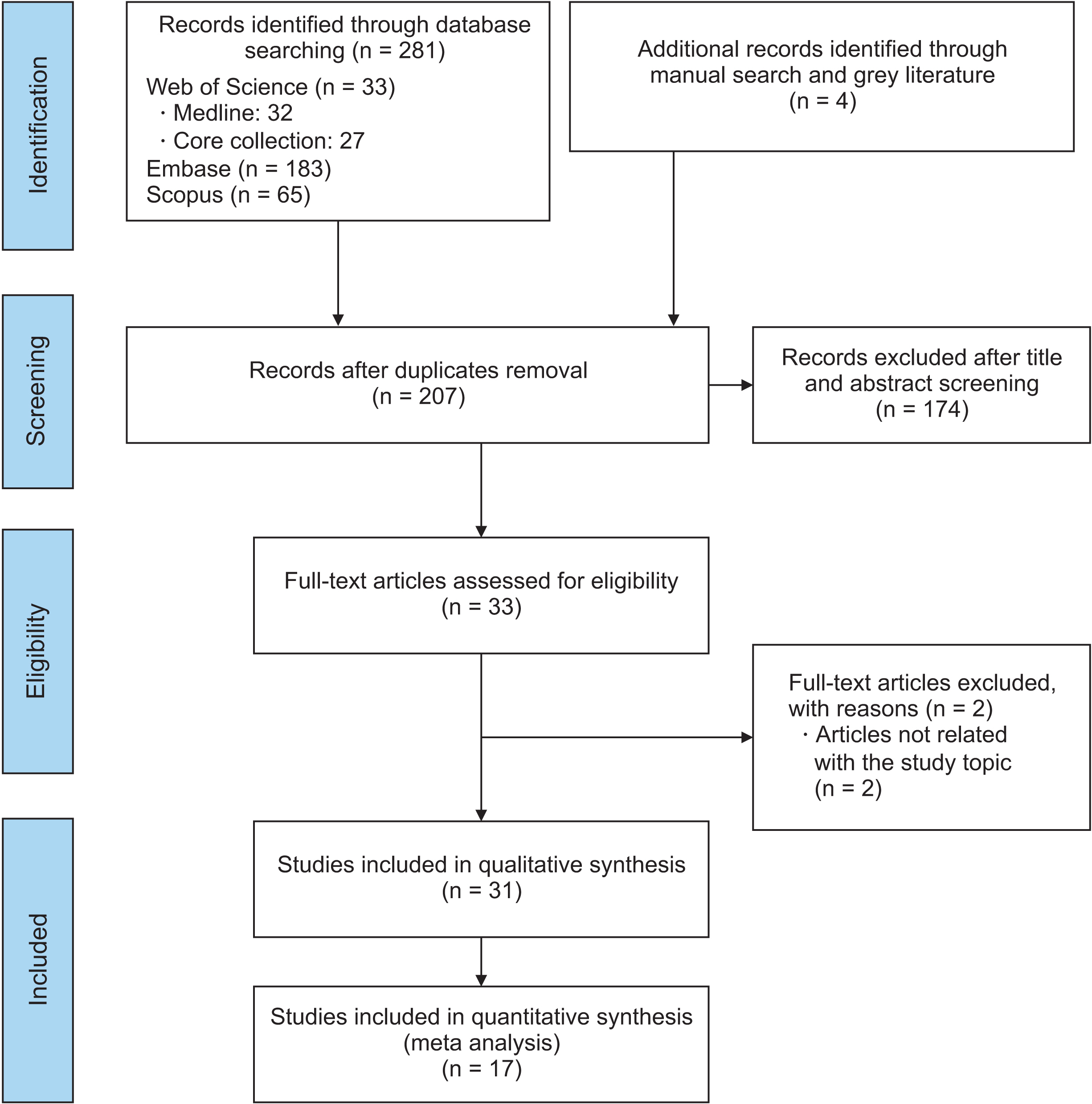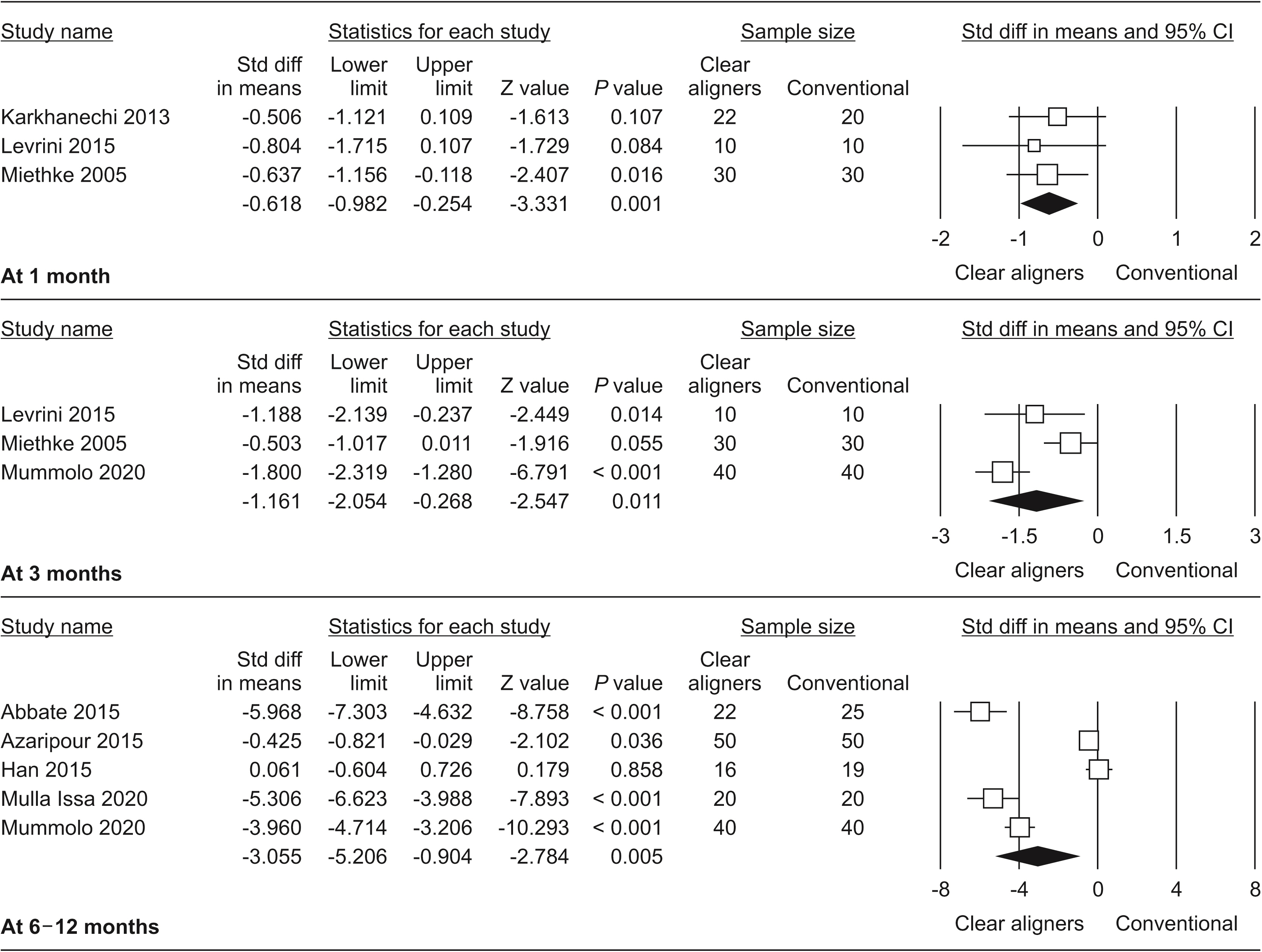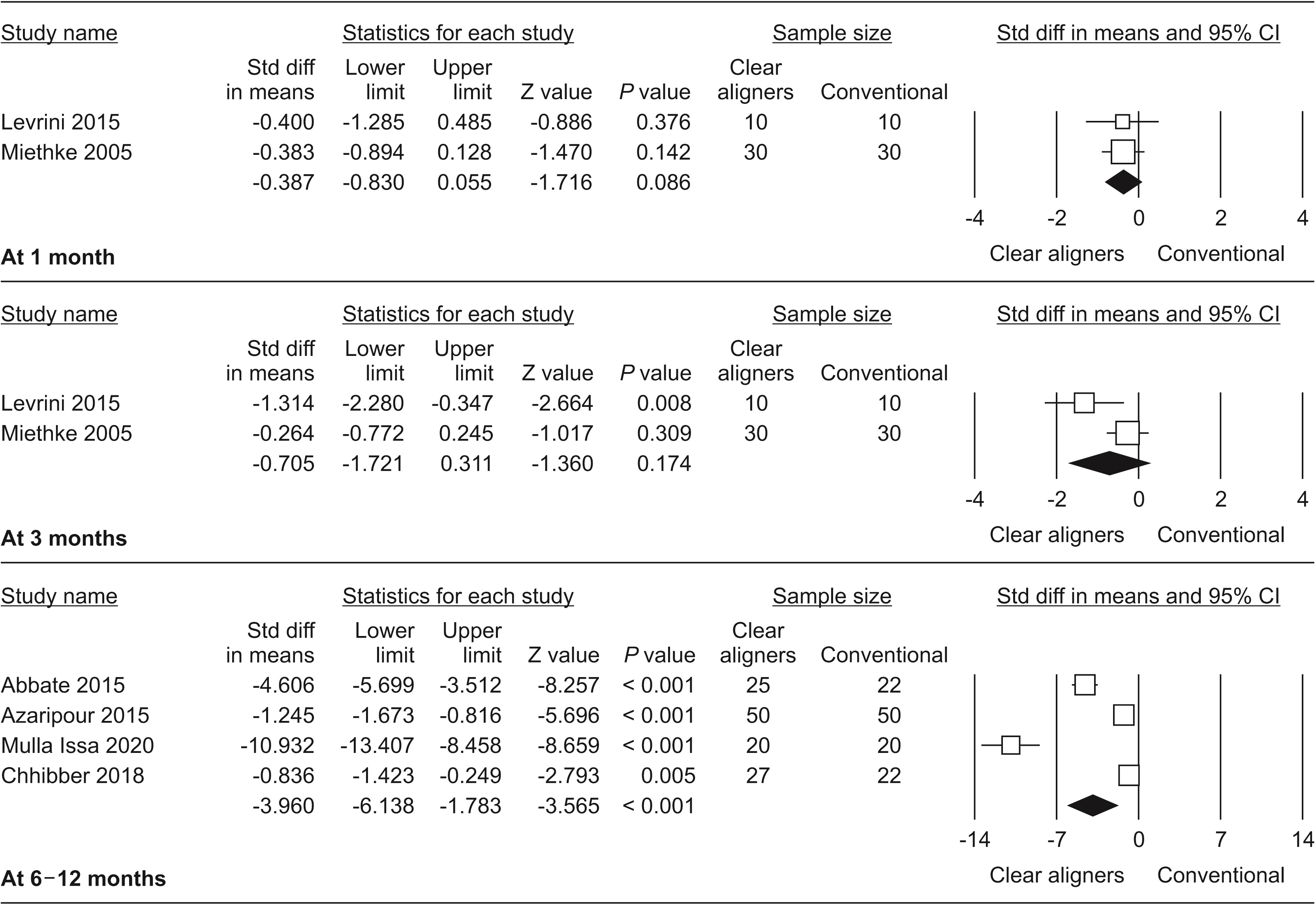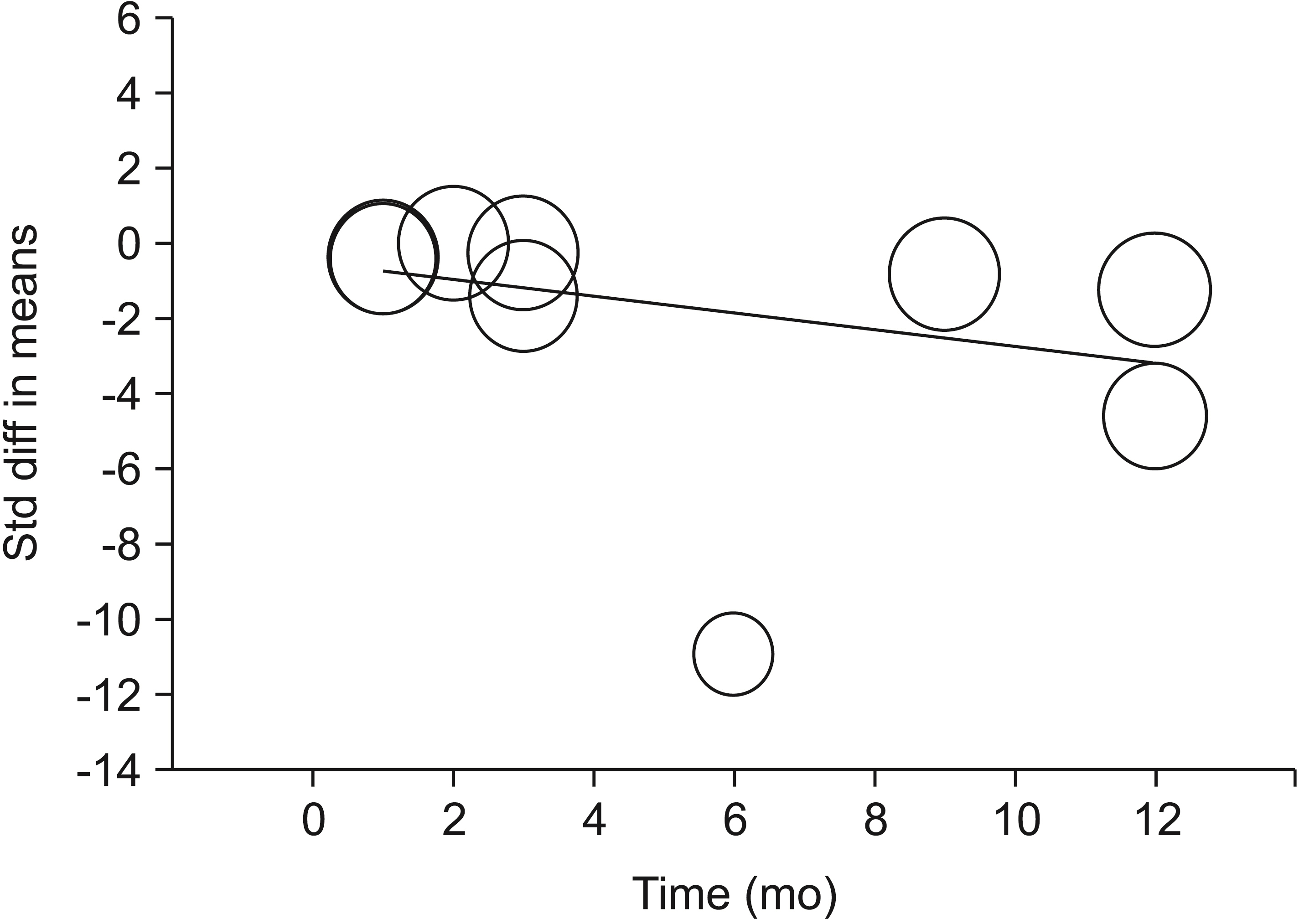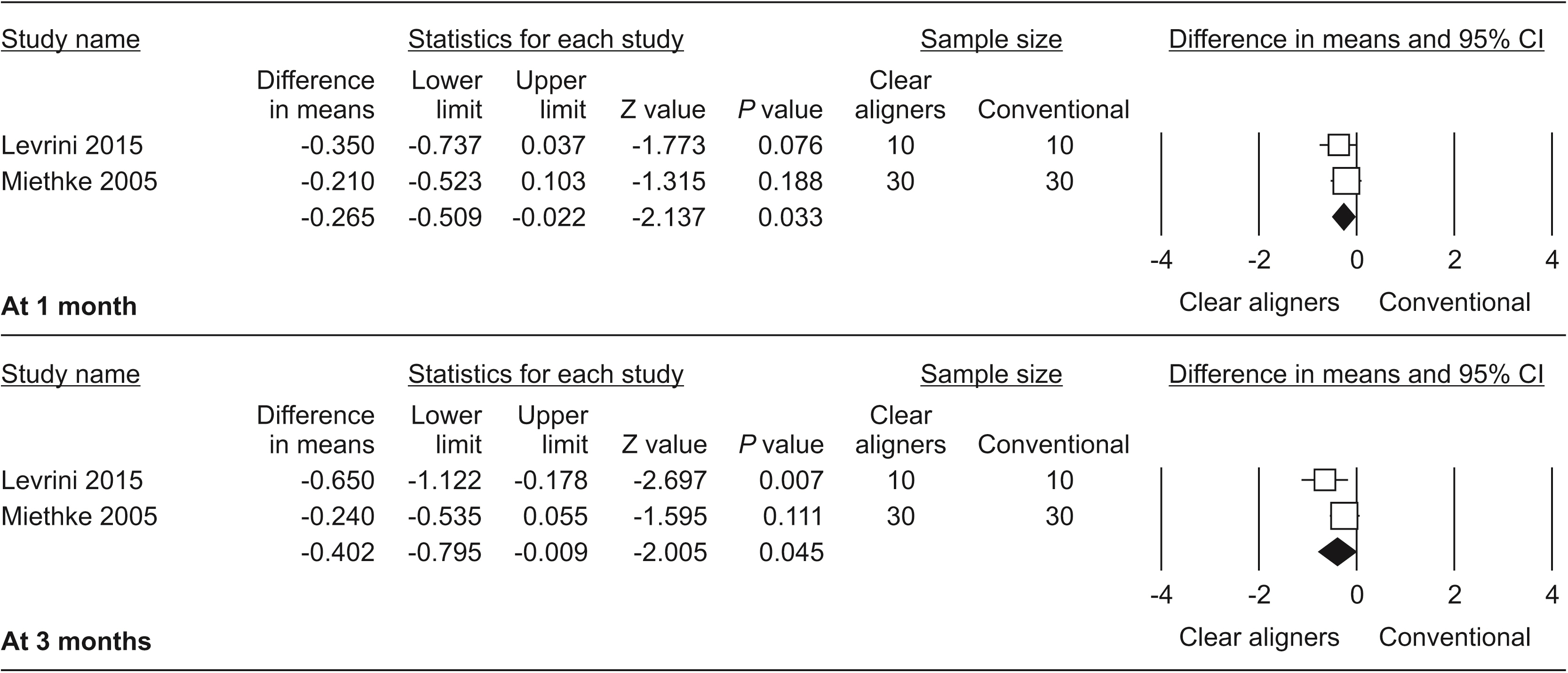Korean J Orthod.
2023 Nov;53(6):374-392. 10.4041/kjod22.272.
Periodontal health status, oral microbiome, whitespot lesions and oral health related to quality of life-clear aligners versus fixed appliances: A systematic review, meta-analysis and meta-regression
- Affiliations
-
- 1Department of Dentistry, Universidad Europea de Valencia, Valencia, Spain
- 2Department of Stomatology, University of Valencia, Valencia, Spain
- KMID: 2548482
- DOI: http://doi.org/10.4041/kjod22.272
Abstract
Objective
Assess and evaluate the different indicators of oral health-related quality of life (OHRQoL) among patients treated with clear aligners (CAs) versus those treated with conventional fixed orthodontics (FAs).
Methods
An electronic search was performed on the database is Web of Science, Scopus, and Embase databases. Randomized and non-randomized control trials, cross-sectional, prospective cohort and retrospective trials were included. Quality was assessed with risk of bias tool and risk of bias in non-randomised studies. Meta-analyses were performed with random effects models, estimating the standardized and non-standardized mean differences, odds ratio and risk ratio as the measure of effect. The effect on time was determined using a meta-regression model.
Results
Thirty one articles were included in the qualitative synthesis and 17 in the meta-analysis. CAs had a significantly lower negative impact on QoL, with an “important” effect size, while the influence of time was not significant. Periodontal indicators plaque index (PI), gingival index (GI), probing depth (PD), and bleeding on probing show significantly better values in patients treated with CAs, with moderate to large effect sizes. PI and GI have a significant tendency to improve over time. In microbiological indicators, CAs present a lower biofilm mass without differences in the percentage of patients with high counts of Streptococcus mutans and Lactobacilli bacteria. The risk of white spot lesion onset is ten times lower in carriers of CAs.
Conclusions
Patients wearing CAs show better periodontal indicators, less risk of white spot development, less biofilm mass and a better QoL than patients with FAs.
Keyword
Figure
Reference
-
1. Tamer İ, Öztaş E, Marşan G. 2019; Orthodontic treatment with clear aligners and the scientific reality behind their marketing: a literature review. Turk J Orthod. 32:241–6. https://doi.org/10.5152/turkjorthod.2019.18083. DOI: 10.5152/TurkJOrthod.2019.18083. PMID: 32110470. PMCID: PMC7018497. PMID: 6a3f5d4013f645febe3722391aeaded5.
Article2. Adobes-Martin M, Montoya-Morcillo ML, Zhou-Wu A, Garcovich D. 2021; Invisalign treatment from the patient perspective: a Twitter content analyses. J Clin Exp Dent. 13:e376–82. https://doi.org/10.4317/jced.57835. DOI: 10.4317/jced.57835. PMID: 33841737. PMCID: PMC8020322.
Article3. Hennessy J, Garvey T, Al-Awadhi EA. 2016; A randomized clinical trial comparing mandibular incisor proclination produced by fixed labial appliances and clear aligners. Angle Orthod. 86:706–12. https://doi.org/10.2319/101415-686.1. DOI: 10.2319/101415-686.1. PMID: 27571371. PMCID: PMC8600838.4. Jeremiah HG, Bister D, Newton JT. 2011; Social perceptions of adults wearing orthodontic appliances: a cross-sectional study. Eur J Orthod. 33:476–82. https://doi.org/10.1093/ejo/cjq069. DOI: 10.1093/ejo/cjq069. PMID: 20651044.
Article5. Marañón-Vásquez GA, Barreto LSDC, Pithon MM, Nojima LI, Nojima MDCG, Araújo MTS, et al. 2021; Reasons influencing the preferences of prospective patients and orthodontists for different orthodontic appliances. Korean J Orthod. 51:115–25. https://doi.org/10.4041/kjod.2021.51.2.115. DOI: 10.4041/kjod.2021.51.2.115. PMID: 33678627. PMCID: PMC7940807.
Article6. Pereira D, Machado V, Botelho J, Proença L, Mendes JJ, Delgado AS. 2020; Comparison of pain perception between clear aligners and fixed appliances: a systematic review and meta-analysis. Appl Sci. 10:4276. https://doi.org/10.3390/app10124276. DOI: 10.3390/app10124276. PMID: 497689d92fc64c4793446243aa770a0b.
Article7. Borda AF, Garfinkle JS, Covell DA, Wang M, Doyle L, Sedgley CM. 2020; Outcome assessment of orthodontic clear aligner vs fixed appliance treatment in a teenage population with mild malocclusions. Angle Orthod. 90:485–90. https://doi.org/10.2319/122919-844.1. DOI: 10.2319/122919-844.1. PMID: 33378505. PMCID: PMC8028462.
Article8. Gu J, Tang JS, Skulski B, Fields HW Jr, Beck FM, Firestone AR, et al. 2017; Evaluation of Invisalign treatment effectiveness and efficiency compared with conventional fixed appliances using the Peer Assessment Rating index. Am J Orthod Dentofacial Orthop. 151:259–66. https://doi.org/10.1016/j.ajodo.2016.06.041. DOI: 10.1016/j.ajodo.2016.06.041. PMID: 28153154.
Article9. Talens-Cogollos L, Vela-Hernández A, Peiró-Guijarro MA, García-Sanz V, Montiel-Company JM, Gandía-Franco JL, et al. 2022; Unplanned molar intrusion after Invisalign treatment. Am J Orthod Dentofacial Orthop. 162:451–8. https://doi.org/10.1016/j.ajodo.2021.03.019. DOI: 10.1016/j.ajodo.2021.03.019. PMID: 35305889.
Article10. Flores-Mir C. 2019; Clear aligner therapy might provide a better oral health environment for orthodontic treatment among patients at increased periodontal risk. J Evid Based Dent Pract. 19:198–9. https://doi.org/10.1016/j.jebdp.2019.05.006. DOI: 10.1016/j.jebdp.2019.05.006. PMID: 31326056.
Article11. Jiang Q, Li J, Mei L, Du J, Levrini L, Abbate GM, et al. 2018; Periodontal health during orthodontic treatment with clear aligners and fixed appliances: a meta-analysis. J Am Dent Assoc. 149:712–20.e12. https://doi.org/10.1016/j.adaj.2018.04.010. DOI: 10.1016/j.adaj.2018.04.010. PMID: 29921415.
Article12. Rossini G, Parrini S, Castroflorio T, Deregibus A, Debernardi CL. 2015; Periodontal health during clear aligners treatment: a systematic review. Eur J Orthod. 37:539–43. https://doi.org/10.1093/ejo/cju083. DOI: 10.1093/ejo/cju083. PMID: 25548145.
Article13. Partouche AJD, Castro F, Baptista AS, Costa LG, Fernandes JCH, Fernandes GVO. 2022; Effects of multibracket orthodontic treatment versus clear aligners on periodontal health: an integrative review. Dent J (Basel). 10:177. https://doi.org/10.3390/dj10100177. DOI: 10.3390/dj10100177. PMID: 36285987. PMCID: PMC9600623. PMID: 56b4c72e69c8431ab22a8ccacd0c778b.
Article14. Oikonomou E, Foros P, Tagkli A, Rahiotis C, Eliades T, Koletsi D. 2021; Impact of aligners and fixed appliances on oral health during orthodontic treatment: a systematic review and meta-analysis. Oral Health Prev Dent. 19:659–72. https://doi.org/10.3290/j.ohpd.b2403661.
Article15. Karkhanechi M, Chow D, Sipkin J, Sherman D, Boylan RJ, Norman RG, et al. 2013; Periodontal status of adult patients treated with fixed buccal appliances and removable aligners over one year of active orthodontic therapy. Angle Orthod. 83:146–51. https://doi.org/10.2319/031212-217.1. DOI: 10.2319/031212-217.1. PMID: 22725616. PMCID: PMC8805524.
Article16. Sifakakis I, Papaioannou W, Papadimitriou A, Kloukos D, Papageorgiou SN, Eliades T. 2018; Salivary levels of cariogenic bacterial species during orthodontic treatment with thermoplastic aligners or fixed appliances: a prospective cohort study. Prog Orthod. 19:25. https://doi.org/10.1186/s40510-018-0230-4. DOI: 10.1186/s40510-018-0230-4. PMID: 30066184. PMCID: PMC6068060. PMID: 7b50acd5664042d29d5f5d71db304939.
Article17. Zhang B, Huang X, Huo S, Zhang C, Zhao S, Cen X, et al. 2020; Effect of clear aligners on oral health-related quality of life: a systematic review. Orthod Craniofac Res. 23:363–70. https://doi.org/10.1111/ocr.12382. DOI: 10.1111/ocr.12382. PMID: 32340082.
Article18. Liberati A, Altman DG, Tetzlaff J, Mulrow C, Gøtzsche PC, Ioannidis JP, et al. 2009; The PRISMA statement for reporting systematic reviews and meta-analyses of studies that evaluate health care interventions: explanation and elaboration. PLoS Med. 6:e1000100. https://doi.org/10.1371/journal.pmed.1000100. DOI: 10.1371/journal.pmed.1000100. PMID: 19621070. PMCID: PMC2707010. PMID: 60caf9425e7348e299a11c2310d3581c.
Article19. Higgins JP, Altman DG, Gøtzsche PC, Jüni P, Moher D, Oxman AD, et al. 2011; The Cochrane Collaboration's tool for assessing risk of bias in randomised trials. BMJ. 343:d5928. https://doi.org/10.1136/bmj.d5928. DOI: 10.1136/bmj.d5928. PMID: 22008217. PMCID: PMC3196245.
Article20. Sterne JA, Hernán MA, Reeves BC, Savović J, Berkman ND, Viswanathan M, et al. 2016; ROBINS-I: a tool for assessing risk of bias in non-randomised studies of interventions. BMJ. 355:i4919. https://doi.org/10.1136/bmj.i4919. DOI: 10.1136/bmj.i4919. PMID: 27733354. PMCID: PMC5062054.
Article21. Duval S, Tweedie R. 2000; Trim and fill: a simple funnel-plot-based method of testing and adjusting for publication bias in meta-analysis. Biometrics. 56:455–63. https://doi.org/10.1111/j.0006-341x.2000.00455.x. DOI: 10.1111/j.0006-341X.2000.00455.x. PMID: 10877304.
Article22. Egger M, Davey Smith G, Schneider M, Minder C. 1997; Bias in meta-analysis detected by a simple, graphical test. BMJ. 315:629–34. https://doi.org/10.1136/bmj.315.7109.629. DOI: 10.1136/bmj.315.7109.629. PMID: 9310563. PMCID: PMC2127453.
Article23. Abbate GM, Caria MP, Montanari P, Mannu C, Orrù G, Caprioglio A, et al. 2015; Periodontal health in teenagers treated with removable aligners and fixed orthodontic appliances. J Orofac Orthop. 76:240–50. https://doi.org/10.1007/s00056-015-0285-5. DOI: 10.1007/s00056-015-0285-5. PMID: 25929710.
Article24. Albhaisi Z, Al-Khateeb SN, Abu Alhaija ES. 2020; Enamel demineralization during clear aligner orthodontic treatment compared with fixed appliance therapy, evaluated with quantitative light-induced fluorescence: a randomized clinical trial. Am J Orthod Dentofacial Orthop. 157:594–601. https://doi.org/10.1016/j.ajodo.2020.01.004. DOI: 10.1016/j.ajodo.2020.01.004. PMID: 32354432.
Article25. Chhibber A, Agarwal S, Yadav S, Kuo CL, Upadhyay M. 2018; Which orthodontic appliance is best for oral hygiene? A randomized clinical trial. Am J Orthod Dentofacial Orthop. 153:175–83. https://doi.org/10.1016/j.ajodo.2017.10.009. DOI: 10.1016/j.ajodo.2017.10.009. PMID: 29407494.
Article26. Gujar AN, Baeshen HA, Alhazmi A, Bhandi S, Raj AT, Patil S, et al. 2019; Cytokine levels in gingival crevicular fluid during orthodontic treatment with aligners compared to conventional labial fixed appliances: a 3-week clinical study. Acta Odontol Scand. 77:474–81. https://doi.org/10.1080/00016357.2019.1607548. DOI: 10.1080/00016357.2019.1607548. PMID: 31027423.
Article27. Levrini L, Abbate GM, Migliori F, Orru G, Sauro S, Caprioglio A. 2013; Assessment of the periodontal health status in patients undergoing orthodontic treatment with fixed or removable appliances. A microbiological and preliminary clinical study. Cumhur Dent J. 16:296–307. http://cdj.cumhuriyet.edu.tr/en/pub/issue/4254/56957. DOI: 10.7126/cdj.2013.1974. PMID: 1eb2cf10c7e44592970c4ca7b363abe6.
Article28. Levrini L, Mangano A, Montanari P, Margherini S, Caprioglio A, Abbate GM. 2015; Periodontal health status in patients treated with the Invisalign(®) system and fixed orthodontic appliances: a 3 months clinical and microbiological evaluation. Eur J Dent. 9:404–10. https://doi.org/10.4103/1305-7456.163218. DOI: 10.4103/1305-7456.163218. PMID: 26430371. PMCID: PMC4569994.
Article29. Miethke RR, Vogt S. 2005; A comparison of the periodontal health of patients during treatment with the Invisalign system and with fixed orthodontic appliances. J Orofac Orthop. 66:219–29. https://doi.org/10.1007/s00056-005-0436-1. DOI: 10.1007/s00056-005-0436-1. PMID: 15959635.
Article30. Shalish M, Cooper-Kazaz R, Ivgi I, Canetti L, Tsur B, Bachar E, et al. 2012; Adult patients' adjustability to orthodontic appliances. Part I: a comparison between Labial, Lingual, and InvisalignTM. Eur J Orthod. 34:724–30. https://doi.org/10.1093/ejo/cjr086. DOI: 10.1093/ejo/cjr086. PMID: 21750242.
Article31. Zamora-Martínez N, Paredes-Gallardo V, García-Sanz V, Gandía-Franco JL, Tarazona-Álvarez B. 2021; Comparative study of oral health-related quality of life (OHRQL) between different types of orthodontic treatment. Medicina (Kaunas). 57:683. https://doi.org/10.3390/medicina57070683. DOI: 10.3390/medicina57070683. PMID: 34356964. PMCID: PMC8304849. PMID: 2687a2c682b4454ba862d54ec3f151da.
Article32. AlSeraidi M, Hansa I, Dhaval F, Ferguson DJ, Vaid NR. 2021; The effect of vestibular, lingual, and aligner appliances on the quality of life of adult patients during the initial stages of orthodontic treatment. Prog Orthod. 22:3. https://doi.org/10.1186/s40510-020-00346-0. DOI: 10.1186/s40510-020-00346-0. PMID: 33458787. PMCID: PMC7811964. PMID: bda10cc2b8ab4c0dafeb793ff276d528.
Article33. Antonio-Zancajo L, Montero J, Albaladejo A, Oteo-Calatayud MD, Alvarado-Lorenzo A. 2020; Pain and oral-health-related quality of life in orthodontic patients during initial therapy with conventional, low-friction, and lingual brackets and aligners (Invisalign): a prospective clinical study. J Clin Med. 9:2088. https://doi.org/10.3390/jcm9072088. DOI: 10.3390/jcm9072088. PMID: 32635196. PMCID: PMC7408790. PMID: ae922d85ec61459999b0394a5d12238d.
Article34. Dallel I, Ben Salem I, Merghni A, Bellalah W, Neffati F, Tobji S, et al. 2020; Influence of orthodontic appliance type on salivary parameters during treatment. Angle Orthod. 90:532–8. https://doi.org/10.2319/082919-562.1. DOI: 10.2319/082919-562.1. PMID: 33378497. PMCID: PMC8028469.
Article35. Gao M, Yan X, Zhao R, Shan Y, Chen Y, Jian F, et al. 2021; Comparison of pain perception, anxiety, and impacts on oral health-related quality of life between patients receiving clear aligners and fixed appliances during the initial stage of orthodontic treatment. Eur J Orthod. 43:353–9. https://doi.org/10.1093/ejo/cjaa037. DOI: 10.1093/ejo/cjaa037. PMID: 32613250.
Article36. Gujar AN, Al-Hazmi A, Raj AT, Patil S. 2020; Microbial profile in different orthodontic appliances by checkerboard DNA-DNA hybridization: an in-vivo study. Am J Orthod Dentofacial Orthop. 157:49–58. https://doi.org/10.1016/j.ajodo.2019.01.026. DOI: 10.1016/j.ajodo.2019.01.026. PMID: 31901280.
Article37. Lombardo L, Palone M, Scapoli L, Siciliani G, Carinci F. 2021; Short-term variation in the subgingival microbiota in two groups of patients treated with clear aligners and vestibular fixed appliances: a longitudinal study. Orthod Craniofac Res. 24:251–60. https://doi.org/10.1111/ocr.12427. DOI: 10.1111/ocr.12427. PMID: 32965768.
Article38. Madariaga ACP, Bucci R, Rongo R, Simeon V, D'Antò V, Valletta R. 2020; Impact of fixed orthodontic appliance and clear aligners on the periodontal health: a prospective clinical study. Dent J (Basel). 8:4. https://doi.org/10.3390/dj8010004. DOI: 10.3390/dj8010004. PMID: 31906577. PMCID: PMC7175220. PMID: 1a4a975e8a7c46a9812a4e62390943d5.
Article39. Miller KB, McGorray SP, Womack R, Quintero JC, Perelmuter M, Gibson J, et al. 2007; A comparison of treatment impacts between Invisalign aligner and fixed appliance therapy during the first week of treatment. Am J Orthod Dentofacial Orthop. 131:302.e1–9. 2006.05.031. DOI: 10.1016/j.ajodo.2006.05.031. PMID: 17346581.
Article40. Mummolo S, Nota A, Albani F, Marchetti E, Gatto R, Marzo G, et al. 2020; Salivary levels of Streptococcus mutans and Lactobacilli and other salivary indices in patients wearing clear aligners versus fixed orthodontic appliances: an observational study. PLoS One. 15:e0228798. https://doi.org/10.1371/journal.pone.0228798. DOI: 10.1371/journal.pone.0228798. PMID: 32330172. PMCID: PMC7182227. PMID: 3d40f89ee25d48f285a46ea0ffad0a1f.
Article41. Mummolo S, Tieri M, Nota A, Caruso S, Darvizeh A, Albani F, et al. 2020; Salivary concentrations of Streptococcus mutans and Lactobacilli during an orthodontic treatment. An observational study comparing fixed and removable orthodontic appliances. Clin Exp Dent Res. 6:181–7. https://doi.org/10.1002/cre2.261. DOI: 10.1002/cre2.261. PMID: 32250562. PMCID: PMC7133731. PMID: d55c47fd7f1d469486c17d02b8c57a54.
Article42. Srinath M, Reddy VK, Reddy GV, Ramyasree K, Swetha T, Sridhar M. 2016; Aligners: a boon for the gingival health of orthodontic patients. J Int Oral Health. 8:490–3. https://www.jioh.org/article.asp?issn=0976-7428;year=2016;volume=8;issue=4;spage=490;epage=493;aulast=Srinath;type=0.43. Wang Q, Ma JB, Wang B, Zhang X, Yin YL, Bai H. 2019; Alterations of the oral microbiome in patients treated with the Invisalign system or with fixed appliances. Am J Orthod Dentofacial Orthop. 156:633–40. https://doi.org/10.1016/j.ajodo.2018.11.017. DOI: 10.1016/j.ajodo.2018.11.017. PMID: 31677672.
Article44. Baseer MA, Almayah NA, Alqahtani KM, Alshaye MI, Aldhahri MM. 2021; Oral impacts experienced by orthodontic patients undergoing fixed or removable appliances therapy in Saudi Arabia: a cross-sectional study. Patient Prefer Adherence. 15:2683–91. https://doi.org/10.2147/ppa.s343084. DOI: 10.2147/PPA.S343084. PMID: 34880603. PMCID: PMC8648268.
Article45. Flores-Mir C, Brandelli J, Pacheco-Pereira C. 2018; Patient satisfaction and quality of life status after 2 treatment modalities: Invisalign and conventional fixed appliances. Am J Orthod Dentofacial Orthop. 154:639–44. https://doi.org/10.1016/j.ajodo.2018.01.013. DOI: 10.1016/j.ajodo.2018.01.013. PMID: 30384934.
Article46. Mulla Issa FHK, Mulla Issa ZHK, Rabah AF, Hu L. 2020; Periodontal parameters in adult patients with clear aligners orthodontics treatment versus three other types of brackets: a cross-sectional study. J Orthod Sci. 9:4. https://doi.org/10.4103/jos.jos_54_17. DOI: 10.4103/jos.JOS_54_17. PMID: 32166083. PMCID: PMC7041336. PMID: 33fe1f73877045919af680b4e0157916.
Article47. Sharma R, Drummond R, Wiltshire W, Schroth R, Lekic M, Bertone M, et al. 2021; Quality of life in an adolescent orthodontic population. Angle Orthod. 91:718–24. https://doi.org/10.2319/062820-592.1. DOI: 10.2319/062820-592.1. PMID: 34260709. PMCID: PMC8549557.
Article48. Alajmi S, Shaban A, Al-Azemi R. 2020; Comparison of short-term oral impacts experienced by patients treated with Invisalign or conventional fixed orthodontic appliances. Med Princ Pract. 29:382–8. https://doi.org/10.1159/000505459. DOI: 10.1159/000505459. PMID: 31842018. PMCID: PMC7445657.
Article49. Azaripour A, Weusmann J, Mahmoodi B, Peppas D, Gerhold-Ay A, Van Noorden CJ, et al. 2015; Braces versus Invisalign®: gingival parameters and patients' satisfaction during treatment: a cross-sectional study. BMC Oral Health. 15:69. https://doi.org/10.1186/s12903-015-0060-4. DOI: 10.1186/s12903-015-0060-4. PMID: 26104387. PMCID: PMC4478712.
Article50. Buschang PH, Chastain D, Keylor CL, Crosby D, Julien KC. 2019; Incidence of white spot lesions among patients treated with clear aligners and traditional braces. Angle Orthod. 89:359–64. https://doi.org/10.2319/073118-553.1. DOI: 10.2319/073118-553.1. PMID: 30556747. PMCID: PMC8117696.
Article51. Han JY. 2015; A comparative study of combined periodontal and orthodontic treatment with fixed appliances and clear aligners in patients with periodontitis. J Periodontal Implant Sci. 45:193–204. https://doi.org/10.5051/jpis.2015.45.6.193. DOI: 10.5051/jpis.2015.45.6.193. PMID: 26734489. PMCID: PMC4698945.
Article52. Lu H, Tang H, Zhou T, Kang N. 2018; Assessment of the periodontal health status in patients undergoing orthodontic treatment with fixed appliances and Invisalign system: a meta-analysis. Medicine (Baltimore). 97:e0248. https://doi.org/10.1097/md.0000000000010248. DOI: 10.1097/MD.0000000000010248. PMID: 29595680. PMCID: PMC5895427.
Article
- Full Text Links
- Actions
-
Cited
- CITED
-
- Close
- Share
- Similar articles
-
- The combined use of computer-guided, minimally invasive, flapless corticotomy and clear aligners as a novel approach to moderate crowding: A case report
- Effects of oral health-related self-efficacy on oral health-related quality of life in male high school students
- Meta-epidemiology
- Effects of the elderly's oral health status and dental care utilization on their health-related quality of life
- A Meta-Analysis on Factors Related to Quality of Life in Heart Transplant Recipients

